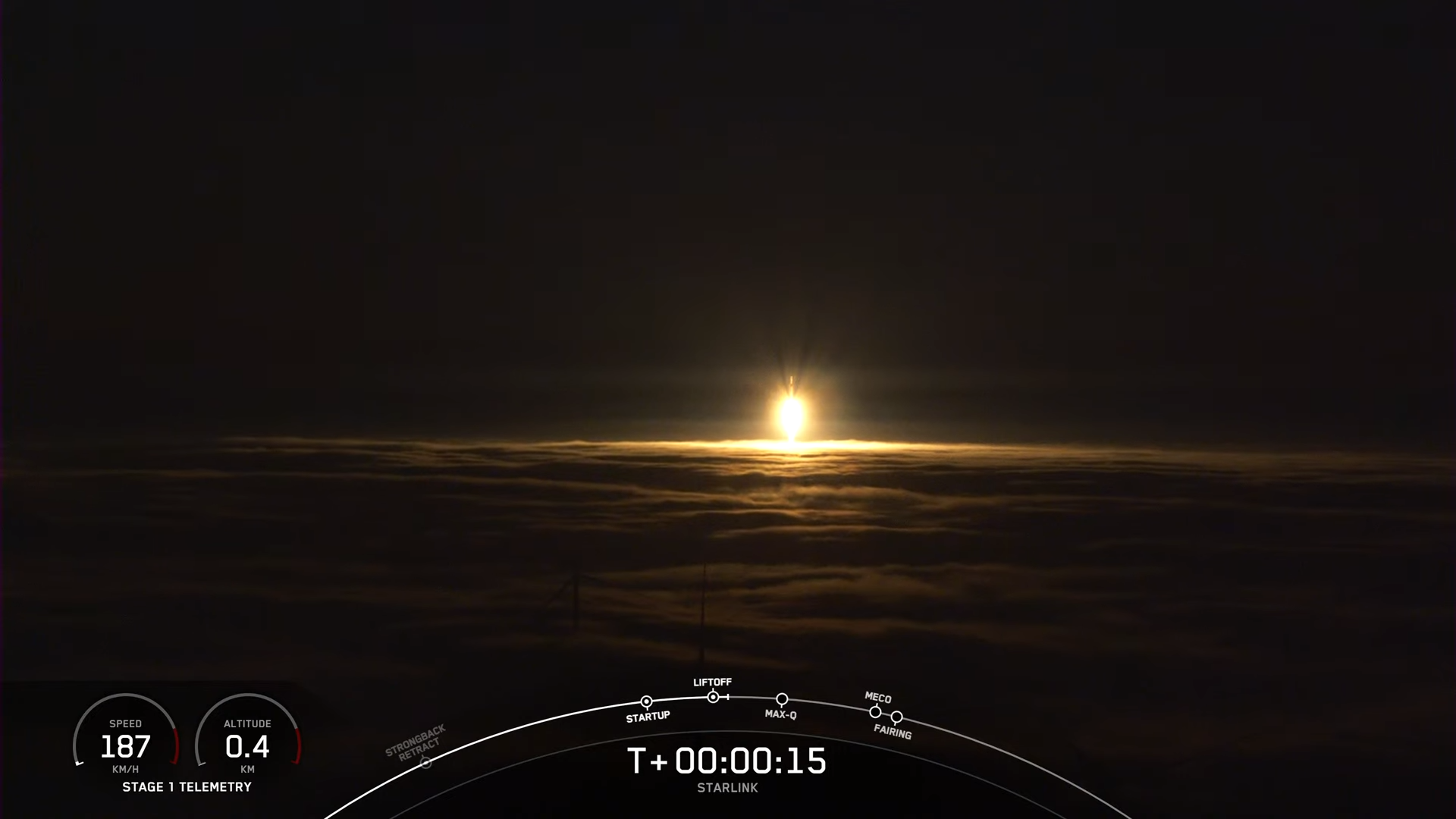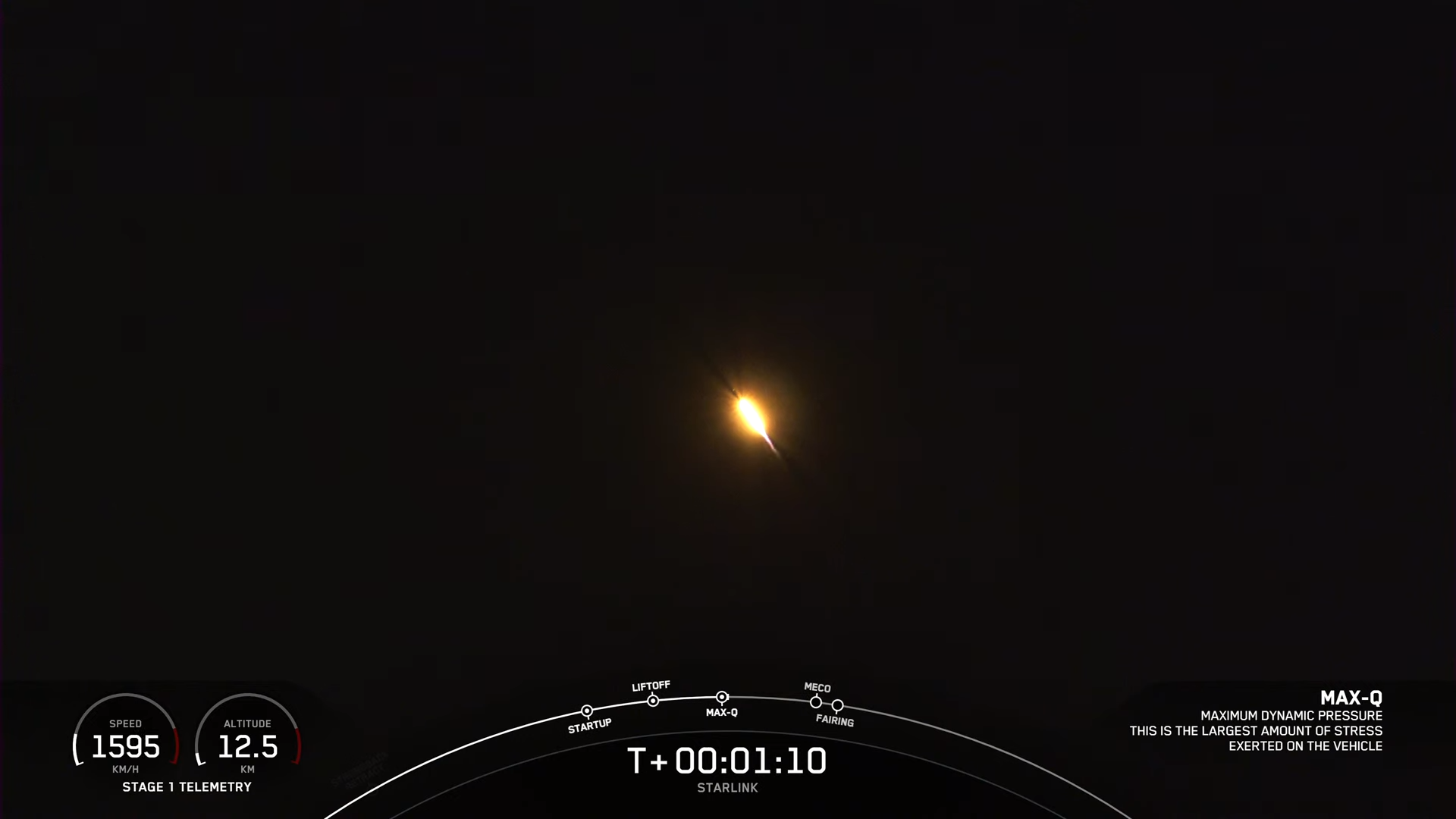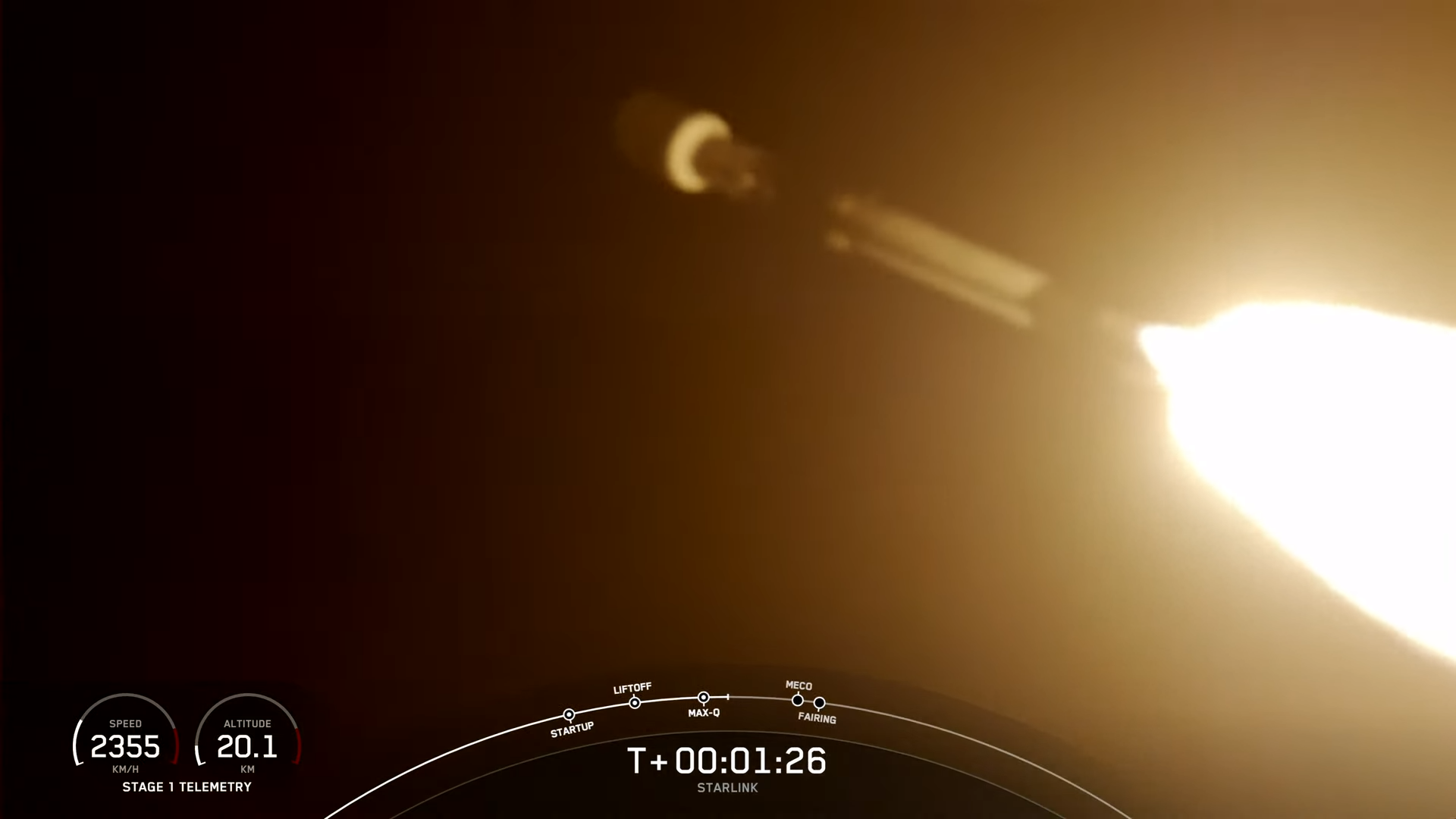
After a scrub at T-5 seconds on Tuesday night, SpaceX successfully launched its fifth Falcon 9 of July late Wednesday, carrying the first batch of downsized Starlink “V2 Mini” internet communications satellites from Vandenberg Space Force Base, Calif. Liftoff of the B1071 core—a dedicated “Vandenberg Falcon”, making her tenth mission and her fourth outing of 2023—occurred from mountain-ringed Space Launch Complex (SLC)-4E at 9:09 p.m. PDT Wednesday and the 15-strong Starlink “stack” was deployed 15 minutes later.
Liftoff was originally scheduled for Tuesday night, with SpaceX electing to forego an opening launch attempt at 9:40 p.m. PDT and aiming instead for the backup T-0 point at 10:25 p.m. Enshrouded in heavy fog, a factor not uncharacteristic of Vandenberg, B1071 was barely visible in the gloom as she transitioned smoothly to “startup” at T-60 seconds and her on-board computers assumed command of the countdown.
The Launch Director issued a clipped “Go for Launch” at T-45 seconds and the count progressed until a dramatic “Abort” call echoed over the net at T-5 seconds. SLC-4E’s sound-suppression water had already come online, flooding the pad surface with water to reduce the reflected acoustical energy at liftoff, but none of B1071’s nine Merlin 1D+ engines ignited before the abort was called.

Moments later, the Launch Director returned onto the net to announce the abort and declare that the vehicle was being safed and propellant offloading would shortly commence. It later became clear that the abort was called in response to “an alert on the second stage”, which SpaceX engineers attended to yesterday, allowing teams to press ahead with a pair of backup launch attempts on Wednesday night, the first at 9:09 p.m. PDT and a second almost an hour later at precisely 10 p.m. PDT.
Fog again covered Vandenberg late Wednesday, rendering the 230-foot-tall (70-meter) booster virtually invisible, the pad lights providing little in the way of illumination in the murk. Liftoff at 9:09 p.m. PDT was heralded by a blinding flash and cacophony of sound, but when B1071 burst through the fog and clouds she rewarded observers with a spectacular view of her uphill climb to space.

In doing so, B1071 becomes the second Falcon 9 to have launched ten or more times out of Vandenberg. In readiness for last night’s launch, the Autonomous Spaceport Drone Ship (ASDS), “Of Course I Still Love You”, departed Port of Long Beach last weekend, bound for a recovery position about 400 miles (640 kilometers) offshore in the Pacific Ocean.
B1071 logged nine treks to space between February 2022 and last month, becoming the first long-term, dedicated “Vandenberg Falcon”. Although several prior Falcon 9s had flown from SLC-4E, they had done so only a couple of times, or had alternated between the West and East Coasts; B1071 has spent her entire career to date at Vandenberg.

She first delivered a pair of classified payloads uphill for the National Reconnaissance Office in February and April of last year, before launching the SARah-1 radar-imaging surveillance satellite for Germany’s Armed Forces in June 2022. And beginning in July 2022—her quickest flight-to-flight turnaround to date, at 34 days—she has launched 214 Starlinks into low-Earth orbit on five dedicated missions.
On one of those missions, last 5 October, she set a new record (with Dragon Endurance and Crew-5) for the shortest interval—now broken—of seven hours and ten minutes between a pair of Falcon 9 flights. And on her most recent prior flight, last month, with the 72-payload Transporter-8 “rideshare” haul, she smoothly executed SpaceX’s 200th fully successful landing of a first-stage booster.

All told, this wizened “Old Guard” of SpaceX’s Vandenberg fleet has lifted 290 large and small satellites for reconnaissance, communications, technology demonstrations, Earth observations, education and amateur radio. And last December, she launched the Surface Water and Ocean Topography (SWOT) mission, a collaborative scientific venture between NASA and the French Space Agency, to investigate surface-water altitudes with centimeter-levels of precision.
Having flown six times last year and now four times thus far in 2023, B1071 has already cemented her credentials as one of Vandenberg’s frequent-flyers, sitting just behind her sister B1063 which wrapped up her own 11th launch from the West Coast earlier this month. And with five on-point touchdowns apiece at the West Coast’s Landing Zone (LZ)-4 and atop the expansive deck of OCISLY, she currently holds the record for the booster with the highest number of “solid-ground” landings at Vandenberg.

Last night’s mission marked the fifth Falcon 9 flight of July, following on the coattails of Europe’s Euclid deep-space observatory on the first day of the month and no less than four Starlink-carrying launches—two from Vandenberg and another pair from storied Space Launch Complex (SLC)-40 at Cape Canaveral Space Force Station, Fla.—which emplaced 139 of these small, flat-packed internet communications satellites into orbit. It was also the 15th Falcon 9 launch from the West Coast, continuing a record-setting 2023 which last month surpassed 2022 as Vandenberg’s most-flown year from the West Coast.
Four boosters—including “newcomer” B1075—have so far lofted 11 Starlink batches, two multi-payload Transporter hauls, communications satellites for OneWeb and Iridium NEXT and the inaugural members of “Tranche 0” of the Transport and Tracking Layer (TTL) for the Space Development Agency (SDA).

Aboard B1071 for last night’s mission was the first 15-strong stack of “V2 Mini” satellites to fly from Vandenberg and the sixth overall batch of these downsized Starlinks to have been orbited since February. The Minis boast three to four times greater “usable” bandwidth than earlier Starlink iterations.
“V2 Minis include key technologies—such as more powerful phased-array antennas and the use of E-Band for backhaul—which will allow Starlink to provide 4x more capacity per satellite than earlier iterations,” SpaceX explained. “Among other enhancements, V2 Minis are equipped with new argon Hall thrusters for on-orbit maneuvering.”

As a network, Starlink facilitates high-speed and low-latency internet provision across 59 sovereign nations and international markets in North and South America, Europe, Asia, Oceania and Africa. Yesterday, it was announced that Kenya has signed up the network, becoming the fourth African nation—after Nigeria, Rwanda and Mozambique—to have done so this year alone.
Florida-based intercity operator Brightline adopted Starlink on its trains earlier in 2023, the first passenger rail service in the world to do so. Additionally, El Salvador’s Ministry of Education has begun integrating Starlink capability into its schools to help close the digital divide between urban and remote rural communities and 50 Rwandan schools are now connected via Starlink’s high-speed internet service.

In the meantime, SpaceX’s launch cadence shows no sign of slowing, as the Hawthorne, Calif.-headquartered organization aims for its 50th Falcon-class flight of the year, potentially by the end of July. Last night’s mission marked No. 48, counting 46 “single-stick” Falcon 9s and a pair of triple-barreled Falcon Heavy boosters.
Flight No. 49 is targeting as early as Saturday evening from the Cape’s SLC-40, although the weather picture looks temperamental and likely to change. “Abnormally high moisture content throughout the atmospheric column will continue the remainder of the week and into the weekend,” noted the 45th Weather Squadron at Patrick Space Force Base in its L-3 weather briefing, issued Wednesday.

“While the Atlantic surface ridge axis is expected to nudge slightly north today and Thursday, an incoming trough passing through the Eastern U.S. is likely to suppress the ridge back south across the Florida Straits by the weekend,” it added. “This will strengthen and deepen the on-shore flow locally and keep the sea-breeze pinned near the coast, enhancing shower and storm threat during the late afternoon and evening hours.”
Coupled with additional moisture in Central and North Florida later this weekend, the probability for weather violations is expected to be “above normal” for both the primary launch attempt on Saturday night and a backup try on Sunday. The 45th identified the front end of each launch window as being especially vulnerable, “when active thunderstorms and their associated cloud cover are likely to be in closer proximity to the pad”.

However, towards the end of the weekend launch windows, these thunderstorms are expected to move away over the Atlantic Ocean, thinning-out the remnant cloud cover. All told, this is expected to yield a picture of only 35-percent favorability near the start of the window, improving to as high as 85-percent-favorable closer to the end.
In readiness for the weekend launch, the East Coast-based Autonomous Spaceport Drone Ship (ASDS), “Just Read the Instructions”, departed Port Canaveral on Wednesday, bound for a recovery position some 390 miles (630 kilometers) offshore in the Atlantic. Recovery weather conditions for the returning Falcon 9 core is expected to present low risks for both the primary and backup opportunities on Saturday and Sunday.






2 Comments
2 Pings & Trackbacks
Pingback:50th Falcon Mission of 2023 Flies, Falcon Heavy Realigns for Friday Night Launch - AmericaSpace
Pingback:As Falcon 9 Passes Year’s 50th Flight, SpaceX Heads for 50th Vandenberg Launch - AmericaSpace